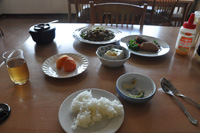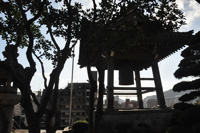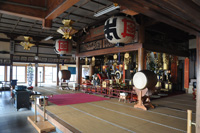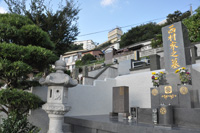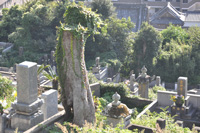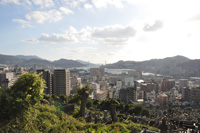 The picture of the left was taken from the street in front of the Jesuit Retreat House in Nagasaki where I made my annual retreat. The view of the harbor is panoramic and even more beautiful at night. Regularly throughout the day you could hear ship horns and the hawks that patrol the Buddhist cemetery on the side of the hill.
The picture of the left was taken from the street in front of the Jesuit Retreat House in Nagasaki where I made my annual retreat. The view of the harbor is panoramic and even more beautiful at night. Regularly throughout the day you could hear ship horns and the hawks that patrol the Buddhist cemetery on the side of the hill.
My director was Fr. John Clarkson, who is originally from St. Louis and came to do mission work after the atomic bombing. He still remembers the devastation in the area and had a lot to say about how the city has developed into a thriving area after being almost totally destroyed. He has been here for almost sixty years and considers this his home. I'm grateful to have had an American for my retreat, and that he was also able to give me an orientation to Japanse cuisine.
The food was prepared by a diocesan order of Japanese nuns who are originally from a chain of islands off Nagasaki. Their cooking relied on every imaginable thing you can harvest from the sea. It was good to start the trip with their cuisine, which prepared me for every crazy thing I would eat on the trip.
I had originally planned to make my retreat at the end of my time in Japan, almost as an afterthought. I began to be concerned that it might not be easy to leave from here to make my way back to Tokyo for the flight out. More importantly, I am finding this to be the best way to start my time in Japan and lay some groundwork for my purpose of giving more thoughtful consideration to issues of concern.
 I am very comfortable living in my head and an Ignatian-style retreat might not have been the best way to encourage an awareness or perception of God's presence, at least for me at this time. I tend to over-analyze or study as a way of avoiding a feeling of intimacy with God. God calls me deeper into the mystery of God's self which transcends words and concepts, and I clutter things by introducing these when they are not invited or required.
I am very comfortable living in my head and an Ignatian-style retreat might not have been the best way to encourage an awareness or perception of God's presence, at least for me at this time. I tend to over-analyze or study as a way of avoiding a feeling of intimacy with God. God calls me deeper into the mystery of God's self which transcends words and concepts, and I clutter things by introducing these when they are not invited or required.
After the first stirrings of a contempletive awareness in seminary, which I attempted to hold on to, I have sensed for some time that now God is inviting this type of communion. God who is infinite creator, infinite in his presence and love and knowledge just wants me to commune with him. Since I was aware of this going into the retreat, I have struggled with what feels like a classical intellectual approach of my director. And he has struggled with how do relate to me along these lines: young, American, non-Ignatian (at this moment). He has done well in understanding my background without a lot detail and, with me, has been obedient to what needs to unfold.
With the person Jesus as the focus of a Jesuit retreat I have made the case to Fr. Clarkson that not only does Jesus seem to be too particular of an image of God to me at the moment, the vast majority among whom he ministers in Nagasaki certainly feel the same way. For so many, Jesus is an example or type of what is known as the scandal of particularity. Pagans or Gentiles might have originally asked why God focused his initial attention on the Jews. Many today ask, at least implicitly, the same thing about Christ. I do not suggest that Christ should or need be seen as any kind of stumbling block, but when others see him simply as a prophet or an enlightened person what should a Christian do? This question comes at a time in my life where I feel beckoned to answer to the call of God who is more unknown than known.
 Another area of conversation with John was the apparant calcification of doctrine, ministerial focus, and perhaps the church on the institutional level. I have valued my relative youth and the opportunity to work with young people. In some ways the pliability of a young mind, beginning to open itself to abstraction, is more open to the proposition of an infinite God. Older people who remain committed to life-long learning and new experiences seem more integrated, adaptable, and open to the natural movements of life. A wise person can see that a purportedly infinite God requires a disposition of openness.
Another area of conversation with John was the apparant calcification of doctrine, ministerial focus, and perhaps the church on the institutional level. I have valued my relative youth and the opportunity to work with young people. In some ways the pliability of a young mind, beginning to open itself to abstraction, is more open to the proposition of an infinite God. Older people who remain committed to life-long learning and new experiences seem more integrated, adaptable, and open to the natural movements of life. A wise person can see that a purportedly infinite God requires a disposition of openness.
After a CT scan a few years ago a doctor told me that my brain exhibited the natural calcification seen in a person my age. So the brain begins to calcify at age 38? This was a bit of a wake up call. I need to be sure that my enthusiasm for discovery, ability to talk to different people, or relate to a rapidly changing world does not calcify at a point where I am comfortable to rest.
If people see Jesus or Christians as a stumbling block to faith I would suggest that our doctrine or church has become monolithic. Couldn't we make the argument that the church has gotten stuck at other important times in history? Every facet of life is seeing so much change that it is possible that we are responding the same way as any other religion that feels it is under siege, that we over-focus on what we consider fundamental. Instead of choosing to meaningfully interact with the culture in which we find ourselves, we run the risk of becoming fundamentalist in our approach, which is already evident.
The above photo is the Church of St. Philip, who was one of the Japanese martyrs, and the retreat house is framed at the very top of the hill by its steeples.
At the event of transfiguration Christ's intention, it seems, was to show that he was one with the Father. He was shown to be conversing with Moses and Elijah as a way to suggest that he was already known to these established patriarchs of faith. The disciples' response was to hold on to the moment and had to be reminded again that Jesus' death and resurrection couldn't be held up by preservation of the present moment.
A Christian should be able to point to moments of transfiguration in one's own life. I can say along with probably every other disciple that there of moments I'd like to hold on to because they feel so good. And sometimes because I am just afraid. It has become obvious to me that I will have to suffer in more ways than I can now anticipate if I am true to my beliefs about the church and my place in it.
I'm posting this on Saturday. I leave for Mt. Koya tomorrow morning. I am confident I can navigate to the next spot. My cell phone is not working for calls, so I'm not able to check in with my family as I said I would.
I have been in Japan six days at this point and I am feeling sadness at leaving Nagasaki. This will be the pattern for leaving each of my stops on this trip.

